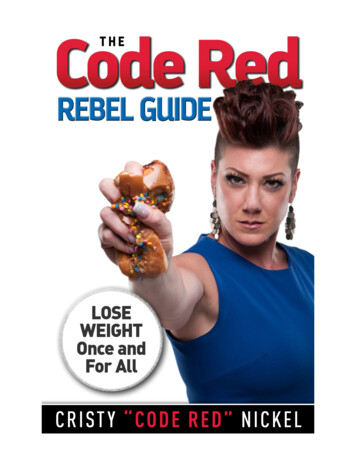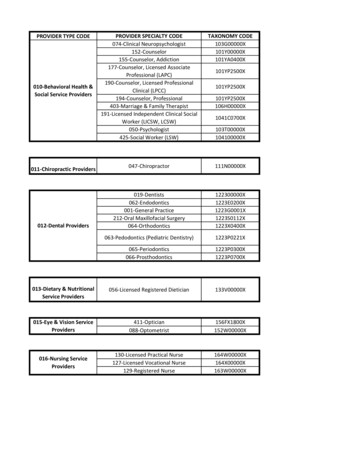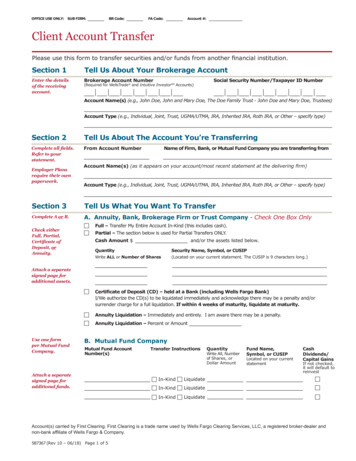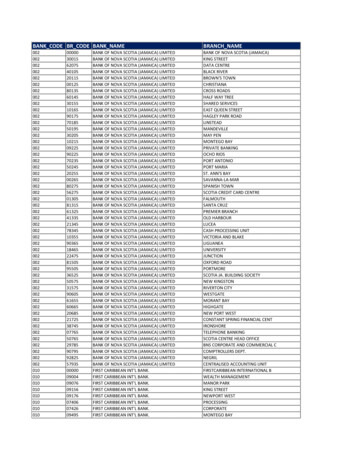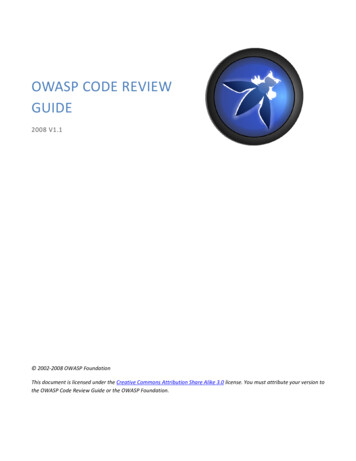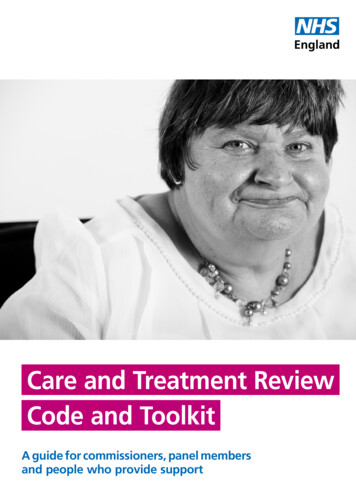
Transcription
Care and Treatment ReviewCode and ToolkitA guide for commissioners, panel membersand people who provide support
NHS England INFORMATION READER BOXDirectorateMedicalNursingFinanceOperations and InformationTrans. & Corp. Ops.Publications Gateway Reference:Specialised CommissioningCommissioning Strategy06659Document PurposeGuidanceDocument NameCare and Treatment Review – Code and ToolkitAuthorAnne WebsterPublication Date2nd Edition 30 March 2018Target AudienceCCG Clinical Leaders, CCG Accountable Officers, Directorsof Nursing, Directors of Adult SSs, NHS Trust Board Chairs,NHS England Regional Directors, NHS England Directors ofCommissioning Operations, Directors of Children's ServicesAdditional Circulation ListAll NHS England Employees, Communications LeadsDescriptionThe main purpose of the CTR Code and Toolkit is to providea solid framework for CTRs in order for them to be deliveredto a consistently high standard across England, and to providecommissioners with the tools they need to carry out CTRsCross ReferenceN/ASuperseded Docs(if applicable)1st Version Published 27 March 2017Action RequiredImplementation of this Code and ToolkitTiming / Deadlines(if applicable)N/AContact Details for furtherinformationImproving Health & Quality teamLearning Disability ProgrammeNHS EnglandRoom 4W23, Quarry House, LeedsLS2 nt StatusThis is a controlled document. Whilst this document may be printed, the electronic version postedon the intranet is the controlled copy. Any printed copies of this document are not controlled. As acontrolled document, this document should not be saved onto local or network drives but shouldalways be accessed from the intranet.
ContentsIntroduction.4Section 1: The PERSONAL Principles of Care and TreatmentReviews.6Section 2: The Standards.8Section 3: The Standards in practice. 11Section 4: CTR Experts by Experience and Clinical Experts:Role Descriptors. 26Section 5: CTR Document Checklist. 36Section 6: Organising a CTR: Commissioner Checklist. 37Section 7: Model Agenda for CTR. 39Section 8: Care and Treatment Review – Provider Checklist. 41Section 9: The Role of the Chair in Care and TreatmentReviews. 45Section 10: Discharge steps and standards. 46Care and Treatment Review Code and Toolkit3
IntroductionThe purpose of the Care and Treatment Review (CTR) Code & ToolkitThe main purpose of the CTR Code and Toolkit is to provide a solid framework for CTRs in order for themto be delivered to a consistently high standard across England.The CTR Code and Toolkit is primarily designed for people who attend CTRs in a professional capacity butis of use to anybody who needs to understand the ‘rules’ of a CTR. There are two easy read booklets, “MyCare and Treatment Review” and “My CTR Planner” booklets which are specifically designed for theperson whose care is being reviewed. The booklets can be found here: www.england.nhs.uk/ctrThe toolkit is intended to offer practical support to people who are planning CTRs, with a checklist forcommissioners and providers to use.The CTR policy includes a set of Discharge Standards and Steps to help commissioners and all involvednavigate through the discharge process, to provide tips, helpful links and a stepped guide, as well as toenable a better experience of involvement for children, young people and adults and their families. Thedischarge standards and steps are at the back of this document.Care and Treatment ReviewsThroughout this Code when the term “people” is used, it is referring to adults, who have learningdisabilities, autism or both. There is a version of this Code that applies to Children and Young People.CTRs are focused on those people who either have been, or may be about to be admitted to a specialistmental health / learning disability hospital either in the NHS or in the independent sector.CTRs bring together those responsible for commissioning and providing services (this will include nurses,social workers, education commissioners and other health, education and social care professionalsalongside strategic commissioners where appropriate) with independent clinical opinion and the livedexperience of people and families from diverse communities with learning disabilities, autism or both.CTRs are driven by the NHS but the involvement of local authorities and education services in the CTRprocess and its outcomes is integral to improving care and treatment for people with learning disabilities,autism or both and their families.The ‘spirit’ in which CTRs are carried out is paramount and is rooted in principles of human rights, personcenteredness and co-production. To this end, the principles and standards were produced in response tothe CTR Policy Engagement exercise undertaken during Autumn 2016.The principles and standards are designed to ensure that all people who have a CTR have a consistentquality CTR experience leading to an effective review of their care and treatment.These standards support the implementation of the CTR Policy, in the community and in hospital, withcriteria that details best practice. Panel members need to familiarise themselves with the principles andstandards, and hold each other to account for delivery against them. The standards will form the basis forquality assurance activity.4Care and Treatment Review Code and Toolkit
Key Lines of EnquiryIn common with the approach taken by the Care Quality Commission, the CTR policy will use Key Lines ofEnquiry (KLOE) to guide and structure the review process.Each KLOE consists of a key question followed by examples of probe questions that reviewers can useto explore and gather information on the issue under discussion. Each KLOE will also suggest sources ofevidence that the review team might look for or ask to be provided to substantiate their findings.The Key Lines of Enquiry will provide information and evidence to enable a summary and feedback for theperson that says:Am I safe?What is my current care like?Is there a plan in place for my future?Do I need to be in hospital for my care and treatment?The 10 KLOEs that a CTR seeks to address are:1. Does the person need to be in hospital?2. Is the person receiving the right care and treatment?3. Is the person involved in their care and treatment?4. Are the person’s health needs known and met?5. Is the use of any medicine appropriate and safe?6. Is there a clear, safe and proportionate approach to the way risk is assessed or managed?7. Are any autism needs known and met?8. Is there active planning for the future?9. Are family and carers being listened to and involved?10. Are the person’s rights and freedoms being protected and upheld?Care and Treatment Review Code and Toolkit5
Section 1The PERSONAL Principles of Care and Treatment ReviewsAt its core, the CTR has a set of principles based around the word PERSONAL which the CTR panel shouldalways uphold. Panel members each have an equal role in making sure these principles are followed:1. Person centred and family centred2. Evidence based3. Rights led4. Seeing the whole person5. Open, independent and challenging6. Nothing about us without us7. Action focused8. Living life in the Community1. Person centred and family centredThe person and their family should be at the centre of the CTR. The CTR checks that the peoplewho provide the person’s care are working in a person and family centred way and that peopleget all the information and support they need to have an active part in the CTR before, during andafter in the way that works best for the people involved.2. Evidence basedThe CTR Panel should all be able to see and hear information to help them understand what isworking or not working about the person’s care. The panel will check that care is carried out to ahigh standard. This is so they can decide with the person and others if anything needs to change orget better.3. Rights ledThe person has the right to be treated as an equal partner in their CTR and to have all the supportthey need to take part. The CTR should uphold the person’s rights. Rights that ought to beconsidered are choice, contact with family, independent advocacy and being able to say what onethinks. Other rights are being treated well, having a good quality of life and being respected forone’s personal life and beliefs.4. Seeing the whole personA CTR is not just about a person’s mental health or how they behave. A CTR is holistic and sees thewhole person. Their quality of life, likes, dislikes, choices, hopes and fears. The CTR will ensure thatthe care is delivered in a way that is culturally sensitive to the person.6Care and Treatment Review Code and Toolkit
5. Open, independent and challengingEach person on the CTR panel can say if something does not seem right about the person’scare. They can ask questions and say if something needs to change. The CTR panel will makerecommendations to improve the care the person receives – doing this is called an action. Actionswill go in to the CTR report that is agreed by the panel at the end of the CTR.6. Nothing about us without usThe person, and their family carers if taking part, should be fully involved in the CTR. From givingconsent, to getting ready, taking part, getting a copy of the CTR report and knowing what ishappening afterwards. The CTR report should also be written in words the person will understand.7. Action focusedAfter the meeting, the CTR report should have clear actions. Actions are things that need to bedone. The actions should be easy to understand. The report will say who needs to do each actionand when it should happen by. The actions should improve the care the person receives now and inthe future. The commissioner will check these things are happening and that the person knows thereason if any action cannot be carried out on time.8. Living life in the communityCTRs are about what is needed to help people live well in their communities. When someone isin hospital, a CTR will ask if they need to be there, or if their care can be provided safely in thecommunity. It will also look at how people are supported to access the community while theyare in hospital. The CTR will check there are good plans in place to keep the person safe in thecommunity. The CTR will also check that the plans give the person the chance to lead as full andindependent a life as possible.Care and Treatment Review Code and Toolkit7
Section 2The StandardsPrinciple 1. Person centred and family centredStandard 1.1 The person and their family will be given information about the Care and Treatment Reviewin advance.Standard 1.2 Before a CTR, the responsible commissioner will ensure that the person has given consent orif the person lacks capacity, that a Best Interests decision has been made.1Standard 1.3 The person will be supported to get ready for the CTR using the “My Care and TreatmentReview” and “My CTR Planner” booklets.Standard 1.4 Reasonable adjustments should be made to the CTR process as required to ensure that theperson is fully involved, present and able to participate as they wish.Standard 1.5 The panel will make time available to meet separately with the person and their family carer.This could be meeting them all together or separately according to the person’s wishes.Standard 1.6 Following a CTR the person and their family are supported to understand what will happennext.Standard 1.7 The commissioner will ensure that the person’s needs are understood and that anappropriately skilled and experienced clinical expert is present on the CTR panel.Principle 2. Evidence basedStandard 2.1 CTRs use a standardised, structured approach to the review of a person’s care by usingspecifically designed Key Lines of Enquiry (KLOE).Standard 2.2 The CTR will look for evidence to support its findings and note these on the KLOE template.Standards 2.3 Specifically the CTR will look for evidence that clinical and best practice guidance has beenfollowed; this will be recorded on the KLOE template.Standard 2.4 Information to help answer the KLOEs will be gathered together before the CTR takes place.Principle 3. Rights ledStandard 3.1 Where there is concern that the person’s human rights may not be being upheldappropriately this will be identified on the KLOE template and relevant action taken.Standard 3.2 The CTR will ask about the provision of independent advocacy for the person.Standard 3.3 The CTR will ask about legal representation for the person (e.g. at tribunals).1Mental Capacity Act, 20058Care and Treatment Review Code and Toolkit
Principle 4. Seeing the whole personStandard 4.1 Each CTR should take around a day to complete.Standard 4.2 The CTR will include the people who are important to the person being reviewed.Standard 4.3 People who are, or who will be, supporting the person should be part of the CTR – includinglocal authority representation.Standard 4.4 The review will ask about physical health, mental health and general wellbeing.Principle 5. Open, independent and challengingStandard 5.1 The review panel is made up of three people and will include: Chair – the person’scommissioner; and two independent advisers – an expert by experience and a clinical expert.Standard 5.2 The chair should be able to demonstrate that they have worked in partnership with the panelmembers including agreement on the content of the report.Standard 5.3 The CTR panel will en
8 Care and Treatment Review Code and Toolkit The Standards Principle 1. Person centred and family centred Standard 1.1 The person and their family will be given information about the Care and Treatment Review in advance. Standard 1.2 Before a CTR, the responsible commissioner will ensure that the person has given consent or if the person lacks capacity, that a Best Interests decision has been .





